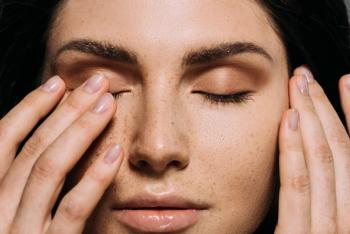
Don’t end up like Old Man Winter
While snow-covered branches and gently falling flakes may be a Normal Rockwell-esque vision for the winter months, icy wind and dry air is a recipe for disaster when it comes to skin.
While snow-covered branches and gently falling flakes may be a Normal Rockwell-esque vision for the winter months, icy wind and dry air is a recipe for disaster when it comes to skin.
Dry, chapped skin is a common struggle for many, and sunburn isn’t a phenomenon reserved for the summer. Read on to see what leading dermatologists recommend.
Skip the scents
Holiday sales on scented lotions abound, but if your patient is telling you that slathering on their vanilla bean lotion just isn’t helping, you may have to draw a line in the sugar scrub.
Sonya Kenkare, MD, FAAD, a board-certified dermatologist at Little Company of Mary Hospital in Illinois, says patients should steer clear of moisturizers with fragrances and other products that have a high-alcohol content.
“People think that lotion is great, but honestly, you need something thick like a cream.”
Speaking of scrubs …
Nada Elbuluk, MD, FAAD, a board-certified dermatologist and clinical assistant professor of dermatology at the Keck School of Medicine at the University of Southern California adds that while it may be tempting to loofah or scrub away that dry flaky skin, it can do more harm than good.
“One thing that people need to be careful of is using loofahs or harsher scrubs,” she says. “That irritates the skin more.”
Watch how you wash
In place or scrubbing and harsh washes, Elbuluk says gentle cleaners are a better option, and antibacterial soaps that can be drying to skin should be avoided. How you shower is also a factor, she says, adding that a long hot shower after exposure to the cold might not be as good as it sounds. Hot showers can dry the skin, Elbuluk says, adding that short showers of 5 to 10 minutes using warm water, followed by a pat dry and moisturizer are more effective at keeping skin healthy.
Get your steam from somewhere else
If a steamy shower is off the table, both Elbuluk and Kenkare recommend adding moisture to the air to combat dry conditions.
“The dry air that’s blowing into our space from our heaters actually really dries the skin out,” Kenkare says.
Place a humidifier in your home-especially in your bedroom at night-to replace moisture in the air, she recommends.
Bigger-or at least thicker-is better
When it comes to moisturizers, there are so many choices, but simple and thick is best, Kenkare says. Neutrogena Norwegian Formula hand cream is a favorite due to its thick, ointment-like texture, she says. CeraVe and other moisturizers with ceramides that hydrate deep below the skin’s superficial layer are also a good option, especially when used in conjunction with skin softeners like Amlactin, Kenkare adds. Aquaphor is also a good option, and has developed a new aerosol product that is faster and easier to apply on the go than the traditional ointment. Kenkare notes that while some might be concerned about clogging pores with thick ointments or lotions, there are a lot of non-comedogenic options available now, like CeraVe, that will hydrate without resulting in the development of comedones. Thick ointments are especially helpful for patients with skin problems that may lead to even drier skin that normal, such as eczema, Elbuluk says. In some cases, Kenkare says these patients may also require steroidal creams or biologics when other options have failed.
Go under cover
No matter which moisturizer you choose, Kenkare says occlusion is key to helping skin absorb and lock in moisture. Creams or ointments applied to the hands and then covered with gloves or socks for the night will work more effectively, she says.
Don’t forget the lips
Hands may be take the brunt of winter damage, but Kenkare and Elbuluk says lip care is also an important part of a winter skin care regimen. Kinkare says she tends to recommend plain petroleum jelly for the lips because it is thick and often fragrance-free, and few people are allergic to its contents. Elbuluk says lip ointments with an SPF of 30 or higher are also a good option.
Suncreen in the winter?
While it may seem as though the sun is absent in winter months, even a small glare’-magnified by the snow-can be damaging to skin.
“It’s kind of misunderstanding that if the weather is cold you can’t get sunburned,” Kenkare says. “Skiers get sunburned all the time and the snow can actually reflect the light from the sun back on to your face.”
“Patients should continue to use sunscreen SPF 30 year-around because there continues to be UV exposure year-round,” Elbuluk adds. “Patients do not need to use a different sunscreen in the summer than from the winter.”
Kenkare says it’s always important, thought, to check expiration dates on chemical sunscreens and reapply if you are planning a long day of exposure.
“If you are facing a lot of wind, might want more frequent applications and something more moisturizing,” she says.
Get cozy
Another important part of winter skin care is protective clothing. Gloves, hats, and scarves to cover the face and hands can offer protection. Not all clothing is created equally, though. Kenkare says while wool is a warm option, it could cause itching and further irritate skin. She suggests pairing woolen products with an protective underlayer to shield the skin.
Physician, heal thyself
Last but not least, Elbuluk has advice for clinicians, who struggle with winter dryness coupled with constant hand-washing or sanitizing during patient care.
“There are numerous hand sanitizers made in lotion form and these can be less drying than the alcohol-based ones that are often used,” Elbuluk says. “Also using a hand cream after each time hands are washed can help.”
Newsletter
Like what you’re reading? Subscribe to Dermatology Times for weekly updates on therapies, innovations, and real-world practice tips.

















